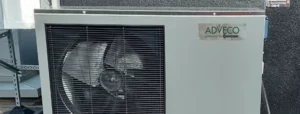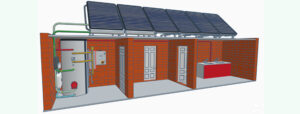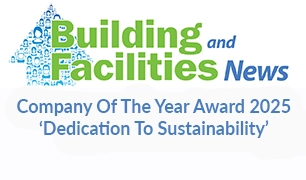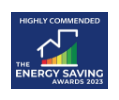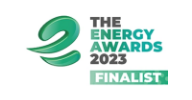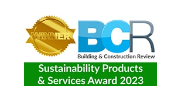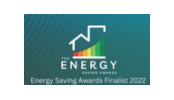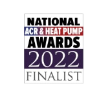Low Carbon and Renewable Water Heating for Offices
Design, Supply and Service of Domestic Hot Water Applications for Office Buildings.
As the specialist in the design and supply of sustainable hot water applications, we can help address the sustainability of office spaces today. Unless a new build, which will be electrical-based, most refurbishments will look to either improve on existing gas systems or aim to completely replace them with electrical alternatives, typically heat pumps and/or electric heating with a boiler.
Office space in England contracted by an estimated 18m square feet during the Covid-19 pandemic, the single largest shake-up of the sector has ever seen. Unsurprisingly developers reacted warily as occupancy levels remained low, and many older offices which no longer met the demands of a modern employer or stringent environmental standards were decommissioned or transferred to domestic applications. This has been especially pronounced in smaller cities and away from central business districts.
Despite this, rents for prime offices – classified by good location, accessibility, and energy efficiency of the premises – are increasing in all major UK cities. This is being driven by developers reacting to pressure to make more versatile office spaces, supporting the growth of agile working and greener by supporting shifting work patterns and meeting new environmental regulations. These workspaces demand fully equipped premises – often with reception, meeting rooms, dedicated cloakrooms and shower facilities, break rooms, on-premises cafés and canteens – and a wider working environment that addresses sustainability in line with corporate social responsibility.

Talk to us today about:
- Meeting domestic hot water (DHW) demands with commercial gas and electric water heaters, boilers, cylinders, packaged plate heat exchangers and electric immersion kits.
- Commercial heating support with ranges of floor-standing and wall-hung gas boilers, carbon steel heating buffers and thermal storage.
- Addressing sustainability through the integration of solar thermal, Air Source Heat Pumps (ASHP) and boxed heat recovery.
- Smart control systems for increased efficiency and managed transition via hybrid approaches that extend the life of viable systems while addressing the need to reduce carbon.
- Bringing all these varied elements together is Adveco’s packaged plant room offering, a bespoke prefabricated system build that makes full use of vacant space whilst leveraging all the advantages of offsite construction for hybrid and all-electric hot water and heating applications.

Live Metering – The most cost-effective and efficient path to sustainability for your office.
If you need assistance with a system for your office, then Adveco’s Live Metering service is for you. Live Metering requires an Adveco engineer to visit your site and install a water meter to provide hot water temperature monitoring for verified water data and comment on the risk of the existing system.
Adveco will return within the month to collect the meter. During these visits we can confirm space and clearances, and installation suitability, and once we have analysed the data give a truly accurate sizing and emissions/costs calculation.
- Quick, non-evasive temporary installation
- Visual site assessment & reporting by Adveco engineer
- Consistent 6 minute data 24 hours per day on existing hot water systems
- 50% of monitoring fee deducted if system recommendation purchased from Adveco
- Bespoke theoretical hot water modelling optimised to work with a building’s existing electrical supply
- Daily & annual hot water demands
- Annual estimated energy consumption
- Annual estimated carbon emissions
- Annual estimated operational costs
Adveco can then advise on a new hot water system which meets the demands of a building while increasing efficiency, lowering carbon emissions, and managing costs.
Heat Pumps for Office Buildings
For new office buildings which are serviced by electricity only, the deployment of air source heat pumps (ASHP) as a method of pre-heating water represent a clear opportunity to introduce low-carbon technology to meet sustainability goals.
Related Products

AIR SOURCE HEAT PUMPs
Solar Thermal for Office buildings
A proven and extremely reliable technology, solar thermal offers a clear path to reducing CO₂ emissions.
Correctly designed and sized to the application, such as office services, solar thermal systems can generate a considerable proportion of the hot water requirements for buildings that are already on-gas with relatively short payback periods on the initial capital expenditure, while leveraging lower-cost gas to meet peak demands.
Recognising the implications on operational expense when switching to all-electric water heating, we would also advocate the use of solar thermal in new builds to offset at least 30% of annual hot water energy demands, reducing both operational costs and carbon emissions.
Related Products
Electric Water Heating for Office buildings
Electric boilers and water heaters help to meet the demands being made of office buildings to cut carbon emissions in line with net zero strategies. Increasingly less reliant on fossil fuels for generation, using the electricity grid is increasingly being specified as a cleaner energy source for water heating. Whether new build or the transformational refurbishment of existing commercial buildings, electrically powered systems provide an efficient, futureproof means for delivering fast, efficient heating for domestic hot water production or central heating needs.
Adveco appliances support a range of projects with wall-mounted and floor-standing systems to cater to the wide needs of office buildings. Packaged hybrid electric systems also offer a more compact, resilient, fast-to-install and easier-to-maintain alternative for those wishing to avoid a reliance on gas energy supplies.
Related Products
Gas Water Heating for your Office
Office buildings with large hot water demands and an existing gas connection may continue to take advantage of this lower-cost energy resource to heat water. Whilst strongly urged to adopt a more environmentally friendly approach to heating a building’s water, many leisure organisations will still find value in remaining on gas. With minimal disturbance for business continuity if replacement is required, manageable capital investment and low operational costs this familiar technology remains a popular replacement option when older appliances fail.
For buildings already on the gas network and seeking to gain lower carbon status, replacement gas-fired appliances working in conjunction with heat pumps or solar thermal provide a familiar, practical, highly effective means for offsetting gas demands to lower carbon emissions of legacy gas-only water heating systems.
Adveco supports office projects with the latest generation of condensing gas water heaters. Harnessing cutting-edge materials, production and energy management technology, it is now easier than ever to maximise fuel use, cutting energy demands, running costs and carbon emissions. All new gas water heaters are also able to support future gas sources with up to 20% blended hydrogen without any alteration. This makes gas water heaters an excellent bridging technology for existing buildings, future-proofing systems in preparation for potentially larger investment decisions in the future as the nationwide net zero strategy is finalised.
Related Products
Office News
FUSION Named Finalist In The National Heat Pump Awards 2025
Getting Started With Sustainable Hot Water Systems
What Is An Electric Water Heater?
Electric boiler Versus Immersion
Understanding Electric Water Heating For Commercial Buildings
Restoring Solar Thermal On Commercial Buildings
Building In Sustainability With Heat Pumps
FUSION Plus Solar Thermal For Cost-Effective Carbon Reduction
Why Stainless Steel Cylinders For Commercial Hot Water?





















